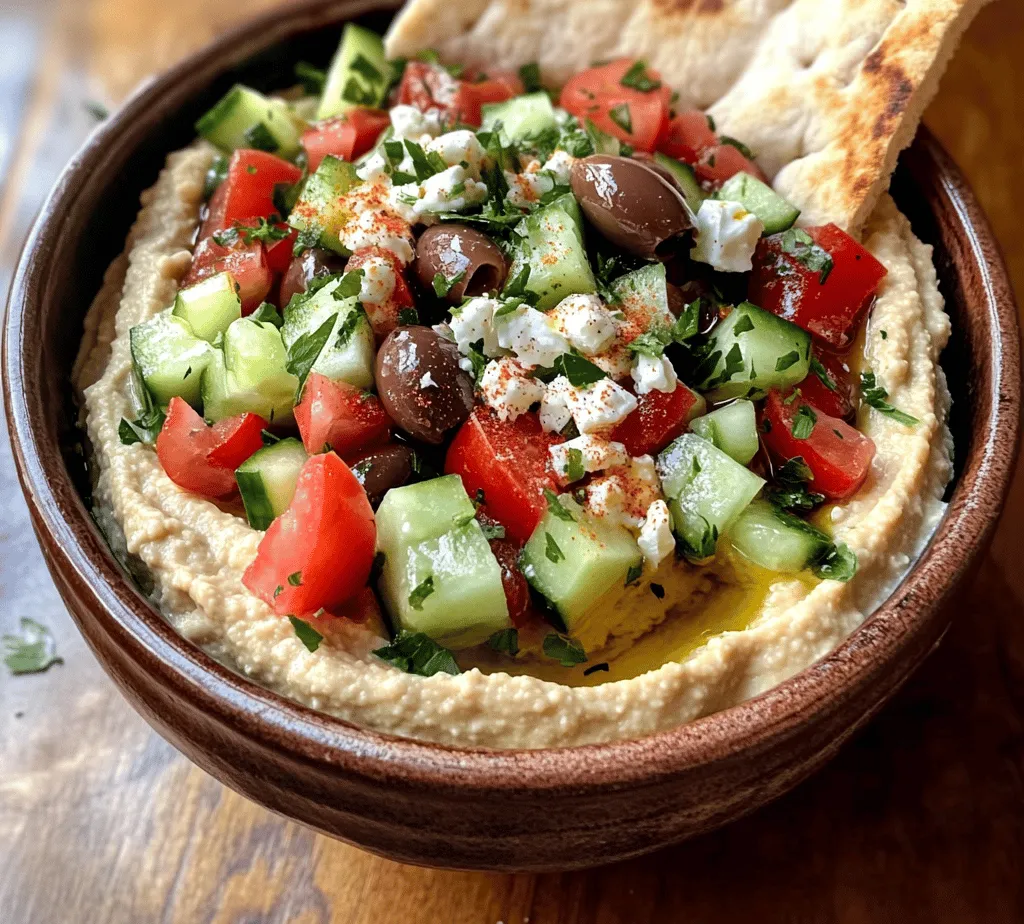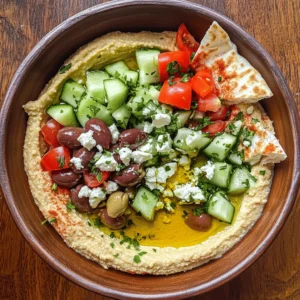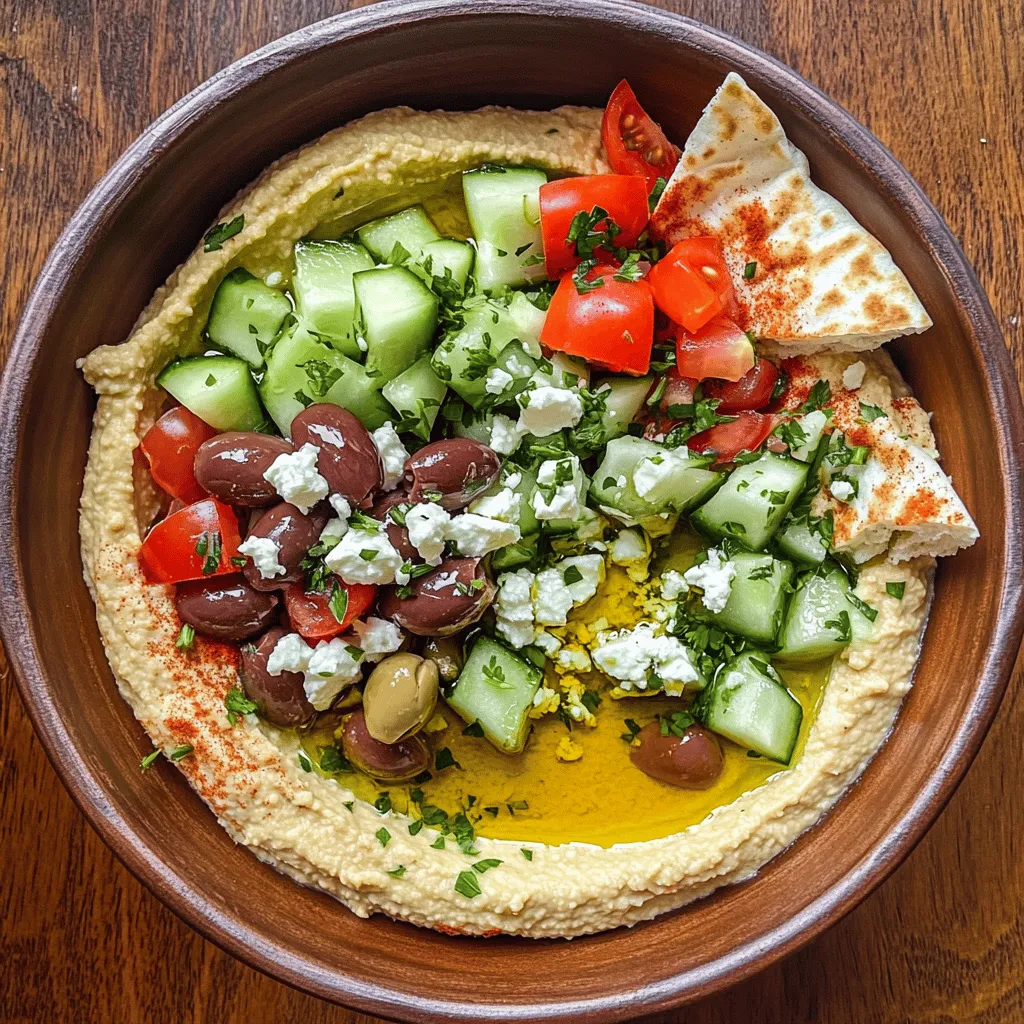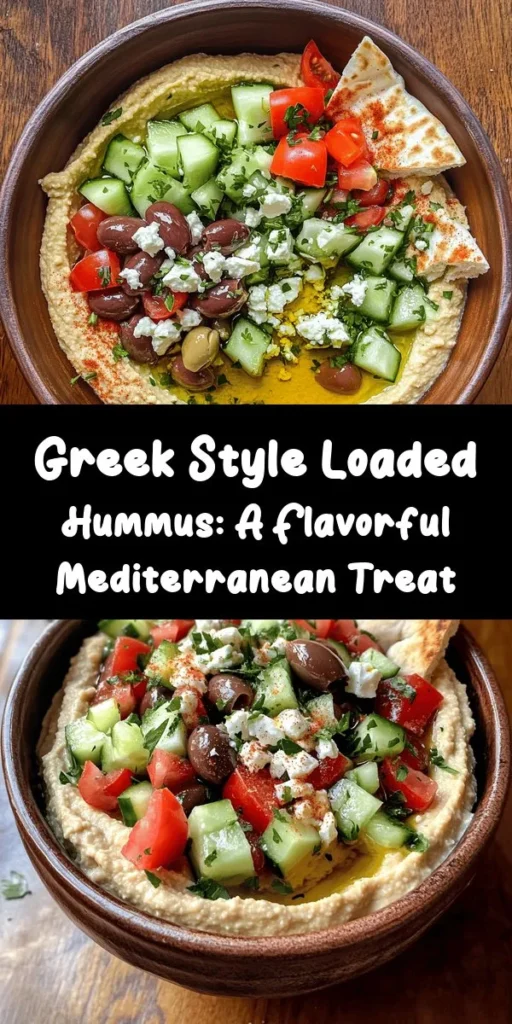Introduction
Hummus, a creamy dip made from blended chickpeas, has long been a staple of Mediterranean cuisine, beloved for its rich flavor and health benefits. Originating from the Middle East, this versatile dish has transcended cultural boundaries, becoming a favorite in kitchens worldwide. With its smooth texture and nutty flavor, hummus serves as the perfect canvas for a variety of toppings, making it an ideal appetizer, snack, or even a light meal.
Among the many variations of hummus, the Greek Style Loaded Hummus stands out, not just for its vibrant flavors but also for its colorful presentation. This dish takes the classic hummus recipe and elevates it with fresh, wholesome ingredients that reflect the essence of Greek cuisine. Imagine a delightful blend of creamy chickpeas, tangy feta cheese, briny Kalamata olives, and a medley of fresh vegetables, all topped with a drizzle of high-quality olive oil. This delicious combination not only tantalizes the taste buds but also provides a plethora of health benefits, making it a guilt-free indulgence.
One of the best aspects of Greek Style Loaded Hummus is its simplicity. This recipe is quick to prepare, requiring minimal cooking, which makes it perfect for busy weeknights, potlucks, or casual gatherings. Whether you’re serving it at a dinner party, enjoying it as a midday snack, or packing it for a picnic, this hummus is sure to impress both friends and family alike.
In this article, we’ll delve into the ingredients that make this recipe special and provide you with step-by-step instructions to create your own Greek Style Loaded Hummus at home.
Understanding the Ingredients
To truly appreciate the flavors and benefits of Greek Style Loaded Hummus, it’s essential to understand each ingredient that contributes to this delightful dish. Below is a detailed description of the key components used in the recipe:
Chickpeas
Chickpeas, also known as garbanzo beans, are the foundational ingredient in hummus. These legumes are not only versatile in cooking but also packed with nutrients. They are an excellent source of plant-based protein, fiber, and essential vitamins and minerals, including folate and iron. The fiber content in chickpeas aids digestion and promotes satiety, making hummus a healthy choice for snacking. Their nutty flavor and creamy texture, when blended, create the perfect base for the hummus.
Tahini
Tahini is a rich, creamy paste made from ground sesame seeds. In Greek Style Loaded Hummus, tahini plays a crucial role in achieving the desired smoothness and creaminess. It adds a subtle nutty flavor that complements the chickpeas beautifully. Additionally, tahini is packed with nutrients, including healthy fats, protein, and various vitamins and minerals. Its richness elevates the overall flavor profile of the hummus while keeping it nutritious.
Olive Oil
A staple in Mediterranean cuisine, olive oil is renowned for its health benefits and flavor enhancement. In this recipe, high-quality extra virgin olive oil is drizzled over the top of the hummus, contributing a fruity, peppery note that elevates the dish. Olive oil is rich in monounsaturated fats, which are heart-healthy and can help reduce inflammation. Furthermore, it contains antioxidants that support overall health, making it an important ingredient in this loaded hummus.
Garlic
Garlic is a powerhouse when it comes to flavor and health benefits. In Greek Style Loaded Hummus, garlic adds depth and aroma, creating a more robust and savory experience. Rich in vitamins C and B6, garlic also boasts antimicrobial and anti-inflammatory properties. The right amount of garlic can transform the flavor of the hummus, making it a standout dish at any gathering.
Lemon Juice
Lemon juice is essential for balancing flavors in many dishes, including hummus. The acidity of fresh lemon juice brightens the flavors, cutting through the creaminess and providing a refreshing contrast. It enhances the overall taste while adding a dose of vitamin C, which supports the immune system. A squeeze of lemon juice not only complements the other ingredients but also adds a zesty kick that elevates this hummus to new heights.
Ground Cumin
Ground cumin introduces earthy notes to the hummus, enriching its flavor profile. This spice is commonly used in Mediterranean and Middle Eastern cooking, lending a warm, aromatic quality to dishes. In addition to its culinary appeal, cumin is known for its health benefits, including aiding digestion and possessing antioxidant properties. Its unique flavor enhances the hummus, making it a more complex and satisfying dish.
Fresh Vegetables
Adding fresh vegetables to Greek Style Loaded Hummus not only enhances its flavor but also contributes to its nutritional value. Ingredients such as diced cucumbers and tomatoes provide crunch and freshness, making the hummus more visually appealing and satisfying. Cucumbers are hydrating and low in calories, while tomatoes are rich in vitamins and antioxidants, including lycopene, which is linked to numerous health benefits.
Kalamata Olives
Kalamata olives are a quintessential part of Greek cuisine, known for their deep purple hue and rich flavor. Their briny taste adds a unique contrast to the creamy hummus, providing salty and savory notes. Rich in healthy fats and antioxidants, Kalamata olives contribute to heart health. When sliced and sprinkled on top of the hummus, they not only enhance the flavor but also add a delightful textural element.
Feta Cheese
Feta cheese is another classic ingredient in Greek cooking that adds creaminess and a salty punch to the hummus. Crumbled feta not only provides a rich flavor contrast but also contributes protein and calcium, making the dish even more satisfying. The tanginess of feta complements the other ingredients, bringing a delightful depth to the loaded hummus.
Fresh Parsley and Paprika
To finish off the Greek Style Loaded Hummus, fresh parsley and a sprinkle of paprika are added. Parsley not only adds a pop of color but also contributes a fresh, herbal note that brightens the dish. Paprika, whether sweet or smoked, introduces a subtle warmth and complexity to the topping. These final touches enhance the presentation and flavor, making the hummus not just delicious but also visually stunning.
Step-by-Step Instructions
Creating Greek Style Loaded Hummus at home is easy and quick, providing you with a tasty dish that can be enjoyed any time. Follow these step-by-step instructions to prepare this delightful recipe:
Step 1: Prepare the Base Hummus
1. Gather Your Ingredients: Start by assembling all the ingredients needed for the base hummus. You will need:
– 1 can (15 ounces) of chickpeas, drained and rinsed
– 1/4 cup of tahini
– 2 tablespoons of extra virgin olive oil
– 1-2 cloves of garlic, minced
– Juice of 1 lemon
– 1 teaspoon of ground cumin
– Salt to taste
– Water, as needed for consistency
2. Blend the Ingredients: In a food processor, combine the drained chickpeas, tahini, olive oil, minced garlic, lemon juice, ground cumin, and a pinch of salt.
3. Process Until Smooth: Blend the mixture until smooth. If the hummus is too thick, add water one tablespoon at a time until the desired consistency is reached. Scrape down the sides of the food processor as needed to ensure all ingredients are well incorporated.
Step 2: Taste and Adjust
4. Taste the Hummus: Once the hummus is blended, taste it and adjust the seasoning as necessary. You may want to add more salt, lemon juice, or garlic according to your preference. The goal is to achieve a balanced flavor that is creamy and satisfying.
5. Achieve the Perfect Consistency: For a creamier texture, continue adding water and blending until you reach the desired consistency. A well-made hummus should be smooth and spreadable, yet thick enough to hold toppings.
Step 3: Prepare the Toppings
6. Chop Fresh Vegetables: While the hummus is blending, chop your fresh vegetables. Dice cucumbers and tomatoes into small pieces, ensuring they are bite-sized for easy scooping.
7. Prepare Kalamata Olives: Slice Kalamata olives into rings or quarters, depending on your preference. Set aside.
8. Crumble Feta Cheese: Crumble feta cheese into small pieces, ready for topping the hummus.
9. Chop Fresh Parsley: Finely chop fresh parsley for garnish, adding a burst of color and freshness.
Step 4: Assemble the Hummus
10. Transfer the Hummus: Once the hummus is prepared, transfer it to a serving bowl. Use the back of a spoon to create a shallow well in the center of the hummus.
11. Add the Toppings: In the well, layer the chopped cucumbers, diced tomatoes, sliced Kalamata olives, and crumbled feta cheese.
12. Drizzle with Olive Oil: Finish by drizzling extra virgin olive oil over the top of the loaded hummus, allowing it to enhance the flavors and add a glossy finish.
By following these simple steps, you can create a vibrant and flavorful Greek Style Loaded Hummus that is sure to impress. The balance of creamy, tangy, and fresh flavors makes this dish a true celebration of Mediterranean cuisine, perfect for any occasion. Stay tuned for the next part, where we will explore tips for achieving the best results and answer some common questions about this delightful recipe.

Layering toppings for visual appeal and flavor enhancement is one of the most enjoyable aspects of preparing Greek Style Loaded Hummus. Begin by spooning the creamy hummus onto a large serving plate or bowl, creating a shallow well in the center to hold your toppings. The vibrant colors and diverse textures of the toppings not only enhance the dish’s visual appeal but also elevate its flavor profile.
Start by adding a generous sprinkle of crumbled feta cheese. The salty, tangy flavor of feta pairs beautifully with the nuttiness of the hummus. Next, follow with a handful of chopped cucumbers and tomatoes, adding a refreshing crunch and juiciness. For a burst of flavor, drizzle some extra virgin olive oil over the top, allowing it to pool in the well you created earlier. This will serve as a delightful dip for your pita bread or veggie sticks.
To finish, add a sprinkle of paprika or sumac for a hint of spice and color, and garnish with freshly chopped parsley or mint to bring a fragrant herbal note to the dish. You can also include a few Kalamata olives, either whole or sliced, for an authentic Mediterranean touch. The combination of these toppings not only looks stunning but also invites your guests to dive in and share in the experience.
When it comes to serving options, consider pairing your Greek Style Loaded Hummus with warm pita bread, which can be cut into wedges for easy dipping. Pita chips are another crunchy alternative that provides a satisfying texture contrast. For a healthier option, serve alongside an assortment of fresh vegetable sticks, such as carrots, bell peppers, celery, and cucumber. This not only makes for a colorful presentation but also allows for a guilt-free snacking experience, encouraging everyone to enjoy the dish.
Nutritional Benefits of Greek Style Loaded Hummus
This delightful dish is not only a treat for the taste buds but also packed with nutritional benefits that make it a great choice for a variety of diets. The primary ingredient, chickpeas, is a powerhouse of nutrition. They are high in protein, making them an excellent option for those looking to increase their protein intake without relying on meat. A serving of chickpeas provides around 15 grams of protein, which is essential for muscle growth and repair.
Tahini, made from ground sesame seeds, adds healthy fats to the mix. These monounsaturated fats are beneficial for heart health and can help maintain satiety, keeping you feeling fuller for longer. When combined with olive oil, another source of healthy fats, the dish becomes even more heart-healthy and satisfying.
Fresh vegetables contribute a wealth of vitamins and minerals, such as vitamin C, vitamin A, and potassium, which are important for immune function and overall health. The garlic used in the hummus not only adds flavor but also provides antioxidant properties, which can help combat inflammation and support overall wellness.
This dish is suitable for various diets, including vegan and vegetarian, as it is entirely plant-based. Additionally, it can easily be made gluten-free by serving it with gluten-free pita or vegetable sticks. The inclusion of whole foods means that the dish is also rich in fiber, aiding in digestion and contributing to a healthy gut.
Culinary Variations and Customizations
One of the best aspects of Greek Style Loaded Hummus is its versatility. Feel free to personalize the dish based on your taste preferences or the ingredients you have on hand. Consider incorporating roasted red peppers for a sweet, smoky flavor or artichokes for a unique twist. If you’re a cheese lover, try adding crumbled goat cheese or a sprinkle of Parmesan for an extra layer of flavor.
Adjusting the spice levels can also transform the dish. If you prefer a little heat, consider adding diced jalapeños or a sprinkle of cayenne pepper. For an herbaceous note, fresh dill or basil can be mixed into the hummus or sprinkled on top. These variations allow you to create a dish that caters to your palate and those of your guests.
When it comes to presentation, get creative! Instead of a traditional bowl, consider serving the hummus in small individual cups or jars for a trendy, modern look at gatherings. Alternatively, you can create a hummus platter featuring multiple varieties of hummus—such as roasted garlic, beet, or avocado hummus—each garnished with their respective toppings. This not only looks impressive but also invites guests to sample a variety of flavors.
Cultural Significance of Hummus in Greek Cuisine
Hummus has a rich history in Mediterranean diets, dating back centuries. While its exact origins are debated, it is widely believed to have originated in the Middle East and gradually made its way into various cultures, including Greek cuisine. In Greece, hummus is celebrated not just as a dip but as a beloved staple that showcases the region’s commitment to fresh, wholesome ingredients.
Traditionally, hummus is often served as part of a meze platter, a selection of small dishes meant for sharing. This communal style of dining is an integral aspect of Greek culture, emphasizing connection and togetherness. Whether enjoyed at family gatherings, festive celebrations, or casual meals with friends, hummus holds a special place in the hearts of many Greeks as a symbol of hospitality.
In Greek culture, hummus is often accompanied by other meze items such as olives, stuffed grape leaves, and tzatziki, creating a vibrant spread that encourages sharing and social interaction. It is a dish that brings people together, fostering an atmosphere of warmth and camaraderie.
Conclusion
Making Greek Style Loaded Hummus at home is a rewarding culinary adventure that allows you to enjoy a delicious and nutritious dish while bringing a piece of Mediterranean culture into your kitchen. With its impressive nutritional profile, diverse serving options, and endless possibilities for customization, this dish is sure to delight both you and your guests.
As you experiment with the recipe, don’t hesitate to make it your own. Whether you choose to layer additional toppings, adjust the spices, or present it in a unique way, the joy of creating this dish lies in the personal touches you can add. Sharing Greek Style Loaded Hummus with family and friends not only promotes the enjoyment of good food but also fosters connection and community. So gather your loved ones, dig in, and savor the delightful flavors of Greece!



